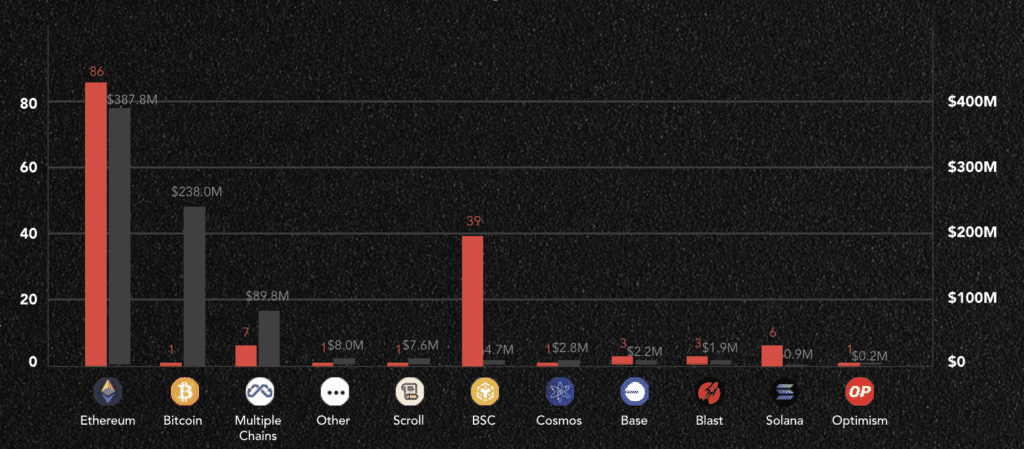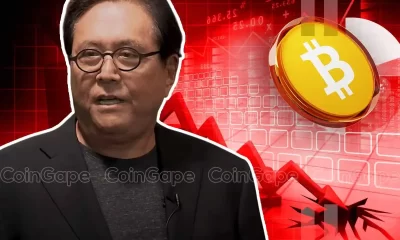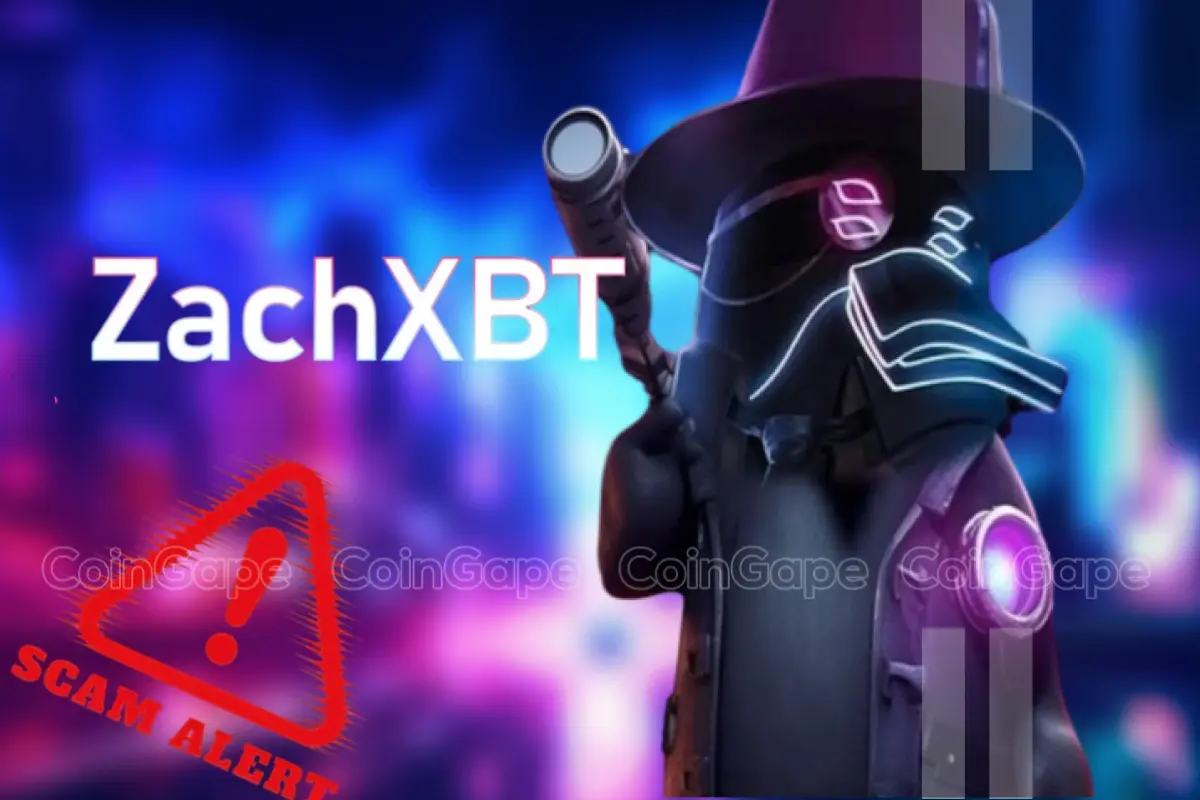Crypto scam
Scammers Decided Not to Operate in TON. Is this good?
Published
2 months agoon
By
admin
Crypto scammers using malware to steal digital assets refused to attack TON users. However, things are not so clear-cut.
Scam Sniffer experts noted that the operators of a drainer popular among scammers rejected the TON network.
In a message published in an unspecified Telegram channel, the drainer creators announced its closure in the TON ecosystem. The main reason is the lack of crypto whales:
The malicious application’s developers are now moving to the Bitcoin blockchain, which will probably create many more opportunities for scammers to rob.
“What’s next? If you enjoyed draining on the TON network you will definitely live draining Bitcoins.”
One of the main reasons for the lack of whales is the vast number of airdrops on TON. They make fraud not the most profitable way to earn money: phishing schemes on The Open Network bring little profit, reducing scammers’ interest.
However, SlowMist founder Yu Xian said that such an assessment of whale activity in TON may need to be more complex. In his opinion, the drainer team may need to pay more attention to the potential of the TON blockchain.
“A phishing group on TON is ready to shut down, arguing that they believe TON has no whale players and is a small community. They have already turned to the Bitcoin ecosystem… Too realistic. Or maybe this gang isn’t smart enough.”
Yu Xian, SlowMist founder
How the TON blockchain became a new haven for scammers
TON has become one of the most successful stories of 2024, with the value of its token growing by more than 100% since the beginning of the year. In addition, integrating TON with the Telegram messenger, which has more than 900 million users, strengthened its position as a potential residence for the widespread distribution of cryptocurrency.
Scammers’ activity in TON arose against the backdrop of the rapid growth of the blockchain. Due to increased interest and investment in TON, fraudulent activity has gained momentum since at least November 2023.
The interest is mainly driven by the increasing popularity of mini-apps. They successfully exploited the popularity of projects such as Notcoin and Hamster Kombat. Typically, the attackers used the popularity of tap-to-earn games.
For example, Kaspersky Lab noted that scammers offered to earn Toncoin (TON) using bots and referral links. To make it easier to deceive users, the scammers recorded a video with instructions, created text manuals, and provided them with many explanatory screenshots.
Tonkeeper explained that the scammers rely on current trends in the ecosystem. For example, they created a token against the backdrop of the excitement caused by the launch of Hamster Kombat. Therefore, the names and tickers of fake tokens are often consonant with the names of popular projects.
“Usually, scammers create tokens before the official listing of the real coin. Check information about the token launch in official sources.”
Tonkeeper team
Experts from BlockAid also noted that attackers used leak tools previously used on the Ethereum and Solana platforms. In September, more than 300 malicious decentralized applications (dapps) were launched on TON, highlighting the growing threats.
What is the most popular blockchain for fraud?
Despite the growing popularity of TON, the blockchain has yet to boast of popularity among fraudsters, according to data from the REKT Database.
Thus, Ethereum became the leader in phishing attacks last year, suffering losses of over $65 million, 91% of the total loss. Arbitrum also suffered losses of $5.2 million, while Bitcoin lost $768,000.
In terms of exploits, Ethereum was also the most affected blockchain in this category, with losses of $482.7 million, while Binance was the most vulnerable to exit scams, with a loss of $74.5 million.
Regarding attackers’ move to the Bitcoin blockchain, CertiK, another well-known company in the blockchain security field, emphasized that scammers are becoming increasingly interested in Bitcoin due to its high transaction volumes, large user base, and significant total value locked (TVL).

Phishing attacks on Bitcoin have increased significantly in recent months. One of the most notable incidents was the attack on a Bitcoin whale that resulted in $238 million in losses, further highlighting the growing risks in this area.
Source link
You may like


Experts say these 3 altcoins will rally 3,000% soon, and XRP isn’t one of them


Robert Kiyosaki Hints At Economic Depression Ahead, What It Means For BTC?


BNB Steadies Above Support: Will Bullish Momentum Return?


Metaplanet makes largest Bitcoin bet, acquires nearly 620 BTC


Tron’s Justin Sun Offloads 50% ETH Holdings, Ethereum Price Crash Imminent?


Investors bet on this $0.0013 token destined to leave Cardano and Shiba Inu behind
Blockchain
Crypto fakes on X nearly doubled, reaching over 300 accounts daily
Published
2 weeks agoon
December 10, 2024By
admin

Bad actors keep ramping up crypto scams, with impersonation accounts surging to over 300 a day, according to blockchain analysts.
Crypto scams on X are once again rising fast, with major accounts hijacked to promote fake tokens. Victims have already lost millions, and experts are warning users to stay alert.
Analysts at blockchain firm Scam Sniffer warned in an X post on Dec. 10 that starting this week, daily impersonation accounts surged by 87%, jumping to over 300 compared to the November average of 160. The spike increases the risk for users as scammers continue to exploit high-profile accounts to push fraudulent schemes.
🚨 SCAM ALERT: Surge in X Impersonations 📈
Our monitoring system detected a significant increase in crypto fake accounts this week, with daily numbers reaching 300+ (vs. Nov avg. 160) 📊
⚠️ Two victims lost over $3M recently from clicking malicious links/signing transactions… pic.twitter.com/eGhG1GPX0r
— Scam Sniffer | Web3 Anti-Scam (@realScamSniffer) December 10, 2024
The analysts note that in one recent case alone, two victims lost over $3 million worth of crypto by interacting with malicious links and signing transactions linked to fake accounts. As crypto.news reported earlier, the scams are particularly prevalent on Solana (SOL), where compromised accounts, including those of major entities like Yahoo News UK, Lenovo India, and Money Control, have been used to push a scam meme coin called HACKED.
Blockchain sleuth ZachXBT, who has been tracking these scams, recently issued a warning to the crypto community, advising users to be extra cautious. “So far, it seems the scammers may have lost money, as the market cap of the HACKED token is a modest $67K, and top traders have barely made $1K,” ZachXBT noted.
The compromised X accounts appear to have been connected to the same malicious site or application. As a precaution, ZachXBT recommends that users revoke any access permissions to unfamiliar sites or apps.
The latest incident follows a series of similar scams, including the recent use of Kylian Mbappé’s account to promote a fake MBAPPE meme coin. Earlier in September, hackers also targeted family members of U.S. president-elect Donald Trump in a scam involving the fake World Liberty Financial coin.
Source link
Crypto scam
Why HAWK Memecoin Crashed from $500M to $60M in Minutes
Published
3 weeks agoon
December 5, 2024By
admin

Hailey Welch, an influencer on social media, launched her own memecoin, Hawk Tuah, on Dec. 4. The cryptocurrency crashed from $500 million to $60 million in just 20 minutes post-launch.
Hailey Welch, commonly known as the Hawk Tuah Girl on the internet, launched her new memecoin of the same name, $HAWK, on Solana on Dec. 4. The coin quickly took off, garnering a market cap of about $500 million, which then crashed to nearly $60 million, all within 20 minutes of launch. The news was further confirmed by Solana (SOL) on X.
Who is Hawk tuah girl?
Welch first rose to fame as the “Hawk tuah girl” after a video of her went viral, making a comical onomatopoeic sound of spitting took over social media earlier this year. With the meme, Welch soon progressed from working a minimum wage job to finding herself in an internet meme culture. Building on this viral moment, Welch launched the HAWK token.
Rise and fall of HAWK token
The massive drop of almost 88% in the HAWK token has reignited the discussion on the high volatility of memecoins in the cryptocurrency community. Some crypto users believe the token was initially built for rug pulling, a cryptocurrency scam in which developers withdraw liquidity or suddenly abandon a project, resulting in the token’s price plummeting.
According to content generated by the community on X, the Hawk token’s supply was allegedly “sniped” shortly after launch. This refers to instances where early investors or bots snatch up large amounts of tokens, leaving the broader community with less access and exposing them to risks. These are often warning signs of the health of the project as it shows few people own the token. However, not all holders have sold their HAWKs, as posted by a user, ZeusLFG, reflecting a strong optimism for the token.
At the time of writing, the token’s trading volume has risen exponentially by 951.67%, as per CoinMarketCap. While the debate goes on, Hawk Token remains under close observation, with members of the community demanding additional disclosures to confirm these claims and keep a close eye on this project.
Source link
24/7 Cryptocurrency News
Pro Gamer Linked to $3.5M Meme Coin Scam: ZachXBT
Published
4 weeks agoon
November 28, 2024By
admin
The crypto market has become the center of attention, with the Bitcoin price aiming at the $100k mark. However, another incident is also gaining investors’ attention these days. A famous crypto investigator, ZachXBT made a major crypto scam finding, linking a pro gamer to a $3.5M meme coin scam. More importantly, these scams were also linked to major celebrity social media account hacks, scam promotions, and much more.
At one point, the crypto industry had earned a name for itself among the biggest finance entities, with $3.31T in global market capitalization. However, the rising crypto scams, theft, and laundering are concerning. Even Changpeng Zhao showed disappointment in memecoin and the rising scams.
ZachXBT Unveils $3.5M MemeCoin Scam and the Culprit
In 2024, the crypto market faced many wallet hacks, rug pull scams, and many other concerning scams. However, celebrity account hacks and the promotion of cryptocurrency-related scams were the most frequent.
Considering the rising case, a popular crypto investigator, ZachXBT, analyzed nine celebrity account hacks and the involved meme coins. He concluded that there is a connection between all these hacks. More importantly, he claimed that a pro-Fortnite gamer known by the name Serpent is the mastermind behind this.
ZachXBT linked this pro gamer in the $3.5M meme coin scam, confirming that he used multiple Pump.Fun memecoin and pump and dump tactics to make millions. Surprisingly, the biggest connection was the Serpent’s ERROR project wallet, which interacted with every social media hacker’s wallets directly or indirectly.
1/ An investigation into how the threat actor Serpent went from a pro Fortnite player to helping steal $3.5M via meme coin scams launched from 9+ account compromises on X & IG and gambling the proceeds away at online casinos. https://t.co/zR6QtuQW8a pic.twitter.com/Y8ovnEnQgj
— ZachXBT (@zachxbt) November 27, 2024
Serpent is known as a pro gamer and blockchain security analyst. He is even the founder of the Sentinel, which is a threat mitigation system but new reports link him with the scam, making it a big controversy. More importantly, he scammed $3.5M and gambled them away in online casinos. The controversy grew as Serpent deleted many of his X posts right after ZachXBT’s claims.
Breaking Down The Serpent’s Crypto Scam
In a detailed X post, ZachXBT revealed his finding to the crypto community, which explained the memecoin scams of more than $3.5M after the scammer compromised various celebrity social media accounts. It includes the account hacks of McDonald’s, Usher, Kabosu Owner, Andy Ayrey, Wiz Khalifa, SPX 6900, etc X (Twitter) and Instagram.


McDonald’s Instagram hack was among the first hacks of the year, where the scammer promoted a memecoin called GRIMACE and earned more than $690k with the pump and dump tactics. This happened on August 21, and the person shifted the funds to two main crypto wallets. The crypto scammer transferred 101.5 SOL to two addresses on September 3 and deployed the SCHRADER token. Interestingly, this token was promoted during the Actor Dean Norris X account hack.
Further, on September 6, the scammer processed Mcdonald’s ATO to a casino deposit address with the beginning address as B2fw. This same account transferred 110 Sol to two new wallet addresses on September 12 and sniped the meme coins which was used during the Usher crypto hack. The same B2fw wallet transferred 4868 SOL to casino deposit address ECb5v, which is connected to Andy Ayrey and the Enoshima Aquarium hack on October 15. Within the same day, 84 SOLs were transferred to ECb5v.
Even the popular AI bot Truth Terminal owner’s X account got hacked on October 29, which stayed compromised for days. In that period, 6 memecoins were promoted on his account. All these involved a common 3GVUs wallet, and the same wallet transferred 169 SOL to Ecb5vs on October 30. However, this is just the mid, the list goes on for others.
Bottom Line
Meme-themed cryptocurrencies gained investors attention in 2024, where many offered heavy gains, mainly the Solana memecoins. As a result, millions of Solana-based meme tokens were launched this year on Pump. Fun, but many were misused for crypto scams. With his recent investigation, ZachXBT has revealed the person behind the $3.5M meme coins scam. The scams also involved hacking celebrity accounts and promoting tokens to boost their price and dumping them all. This way, the scammer or alleged pro-Fortnite gamer Serpent made heavy returns, but others were left with losses.
Pooja Khardia
With a deep-seated passion for reading and five years of experience in content writing, Pooja is now focused on crafting trending content about cryptocurrency market.
As a dedicated crypto journalist, Pooja is constantly seeking out trending topics and informative statistics to create compelling pieces for crypto enthusiasts. Staying abreast of the latest trends and advancements in the field is an integral part of her daily routine, fueling a commitment to delivering timely and insightful coverage
Disclaimer: The presented content may include the personal opinion of the author and is subject to market condition. Do your market research before investing in cryptocurrencies. The author or the publication does not hold any responsibility for your personal financial loss.
Source link

Experts say these 3 altcoins will rally 3,000% soon, and XRP isn’t one of them

Robert Kiyosaki Hints At Economic Depression Ahead, What It Means For BTC?

BNB Steadies Above Support: Will Bullish Momentum Return?

Metaplanet makes largest Bitcoin bet, acquires nearly 620 BTC

Tron’s Justin Sun Offloads 50% ETH Holdings, Ethereum Price Crash Imminent?

Investors bet on this $0.0013 token destined to leave Cardano and Shiba Inu behind

End of Altcoin Season? Glassnode Co-Founders Warn Alts in Danger of Lagging Behind After Last Week’s Correction

Can Pi Network Price Triple Before 2024 Ends?

XRP’s $5, $10 goals are trending, but this altcoin with 7,400% potential takes the spotlight

CryptoQuant Hails Binance Reserve Amid High Leverage Trading

Trump Picks Bo Hines to Lead Presidential Crypto Council

The introduction of Hydra could see Cardano surpass Ethereum with 100,000 TPS

Top 4 Altcoins to Hold Before 2025 Alt Season

DeFi Protocol Usual’s Surge Catapults Hashnote’s Tokenized Treasury Over BlackRock’s BUIDL

DOGE & SHIB holders embrace Lightchain AI for its growth and unique sports-crypto vision
182267361726451435

Why Did Trump Change His Mind on Bitcoin?

Top Crypto News Headlines of The Week

New U.S. president must bring clarity to crypto regulation, analyst says

Will XRP Price Defend $0.5 Support If SEC Decides to Appeal?

Bitcoin Open-Source Development Takes The Stage In Nashville

Ethereum, Solana touch key levels as Bitcoin spikes

Bitcoin 20% Surge In 3 Weeks Teases Record-Breaking Potential

Ethereum Crash A Buying Opportunity? This Whale Thinks So

Shiba Inu Price Slips 4% as 3500% Burn Rate Surge Fails to Halt Correction

Washington financial watchdog warns of scam involving fake crypto ‘professors’

‘Hamster Kombat’ Airdrop Delayed as Pre-Market Trading for Telegram Game Expands

Citigroup Executive Steps Down To Explore Crypto
Mostbet Güvenilir Mi – Casino Bonus 2024

NoOnes Bitcoin Philosophy: Everyone Eats
Trending

 3 months ago
3 months ago182267361726451435

 Donald Trump5 months ago
Donald Trump5 months agoWhy Did Trump Change His Mind on Bitcoin?

 24/7 Cryptocurrency News4 months ago
24/7 Cryptocurrency News4 months agoTop Crypto News Headlines of The Week

 News4 months ago
News4 months agoNew U.S. president must bring clarity to crypto regulation, analyst says

 Price analysis4 months ago
Price analysis4 months agoWill XRP Price Defend $0.5 Support If SEC Decides to Appeal?

 Opinion5 months ago
Opinion5 months agoBitcoin Open-Source Development Takes The Stage In Nashville

 Bitcoin5 months ago
Bitcoin5 months agoEthereum, Solana touch key levels as Bitcoin spikes

 Bitcoin5 months ago
Bitcoin5 months agoBitcoin 20% Surge In 3 Weeks Teases Record-Breaking Potential



✓ Share: